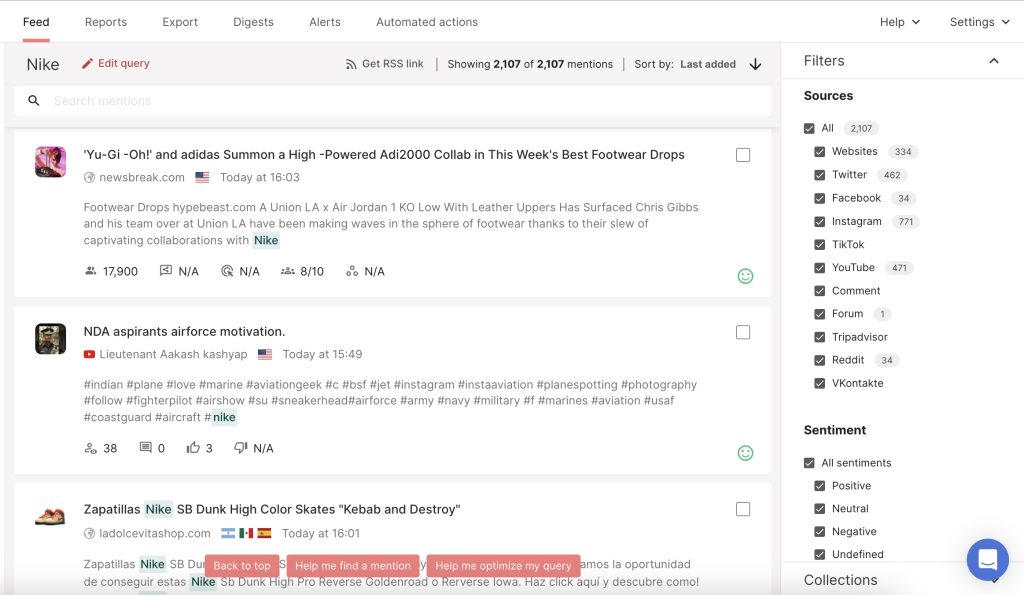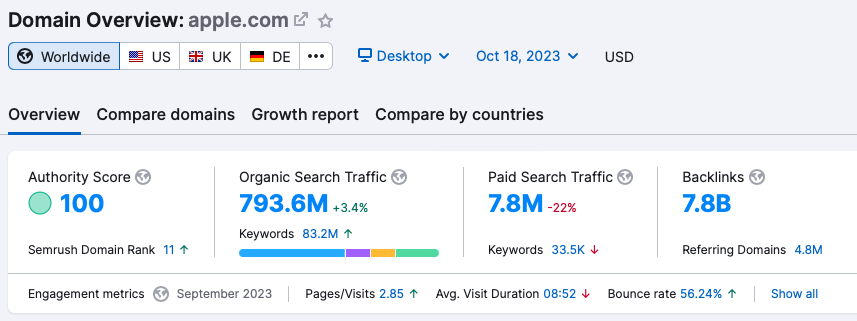The landscape of business-consumer communication has evolved with the evolution of marketing tools. At the forefront of this transformation are digital marketing solutions. These solutions include a range of digital channels, including search engines, social media, email, text messages, and multimedia platforms.
Digital marketing also embraces automation and AI marketing, which provide valuable insights for campaign strategies and content creation. It’s essential to recognize the diverse range of devices, as well as the emerging ‘spaces’ like virtual and augmented reality, where consumers engage with marketing campaigns and content.
💡 Read Creating a Marketing Strategy that Works: Benefits, Steps, Tools
Selecting the right mix of digital marketing solutions can significantly boost your return on investment (ROI) for every campaign. Let’s delve into these innovative solutions one by one.

Real Time and Other Types of Analytics
Real-time analytics involves tools and processes for gathering, analyzing, and promptly acting upon current data. This approach provides insights into your products and customer behavior. You can obtain these insights by querying your analytics tool when needed (on-demand analytics). Or by setting up the system to alert you or take actions as data is generated (continuous analytics).
Data sources for analytics encompass website data, digital marketing data (like social media interactions and keyword analysis), product data (including conversion events and popular or unpopular features), and internal customer data (such as transactions and complaints). In-the-moment insights empower you to take swift actions, like personalizing tests and offers, refining products, or responding to increased demand by adjusting your inventory. Google Analytics, for instance, is a widely used tool for these purposes.
Real-time analytics falls within the category of descriptive analytics. This is a straightforward approach employed by 90% of organizations to shape future campaigns. When combined with historical data, like performance reports, corporate social media profiles, and inventory records, this type of analytics helps you understand what led to past successes or failures, guiding your decisions for upcoming endeavors. Business Intelligence platforms can also shed light on consumer behavior and industry trends in the use of marketing tools.
On the other hand, predictive analytics relies on past trends and patterns to forecast the future. This aids in strategic planning and goal-setting. Concurrently, prescriptive analytics uses simulations and optimization techniques. It often involves AI data analysis, to explore possible actions and find solutions based on insights from descriptive and predictive analytics. This approach enhances project development and management, enabling targeted advertising, pricing adjustments, and other business decisions.
Social Listening and Media Monitoring
Social listening and media monitoring play a vital role in understanding and engaging with your online audience. It involves tracking mentions of your brand on various social networks. On the other hand, media monitoring goes beyond simply identifying words associated with your brand; it also keeps an eye on your competitors, industry trends, and relevant topics.
Media monitoring encompasses websites, blogs, review sites, and forums, providing a comprehensive view of the digital landscape. With social listening tools, you can answer essential questions such as:
- Where are people discussing my brand on social media?
- How does my brand’s online presence compare to that of my competitors?
- What are people’s sentiments towards my brand – positive or negative?
- How does the public perceive my brand in comparison to my competitors?
- Who are the key influencers discussing my brand?
These insights can help you understand what your audience expects from your business or industry. You can later use these insights to inform your future content, campaigns, or product innovations.

Media monitoring platforms, like Determ, enable you to actively participate in conversations that matter to your target audience. By engaging in these discussions, you can shape the narrative around your brand. In this way, tools like Determ assist in managing your brand’s reputation, mitigating potential crises stemming from negative mentions, and evaluating the success of your marketing efforts.
Email and Text Messaging
Email and text messaging are becoming increasingly essential as third-party data sources diminish. To expand your customer database, it’s crucial to rely more on your brand’s digital marketing resources. These channels provide valuable first-party data about your customers, making it possible to create personalized and targeted content. For instance, you can segment your email list by location to tailor promotions to specific regions.
Monitoring who opens your emails and text messages, as well as their responses to promotions, videos, events, and other campaigns, can provide valuable insights for tailoring future offers and content.
To optimize your email marketing efforts, automation is your best friend. It streamlines repetitive tasks such as segmentation, scheduled sending, and lead scoring, making your marketing efforts more efficient and effective. Whatever your business, Mailchimp is a tool that can help you integrate SMS into the rest of your marketing efforts with a powerful set of tools, automations, and analytics that work alongside your email and social media campaigns.
Pay-per-click (PPC) Advertising
Pay-per-click (PPC) advertising is a direct route to bring your target audience to your website. In PPC, you pay the publisher for each click your ad receives during a specified period. Advertisers compete by bidding on the amount they’re willing to pay for each click.
Managing PPC involves the strategic selection of keywords and phrases that are most relevant to your business. These chosen terms should be incorporated into the ads you create and submit, typically to platforms like Google. Once your chosen keywords and phrases are approved by the search engine, your ad appears when a user includes one of these terms in their search. Paid ads or sponsored links are usually displayed prominently at the top of search engine results pages.
On platforms like Facebook, you can pay to have custom images, videos, or slideshows appear in the news feeds of your specified audience. Twitter allows you to target your desired viewers when promoting profile badges or a series of posts. LinkedIn also permits you to send ads to users based on their industry and career specialization.
Segmenting your audience based on demographics, interests, or location enhances personalization and potentially increases the click-through rate of your ads. Leveraging first-party data, especially for retargeting website visitors who haven’t yet completed a desired action, can be highly effective.
However, manually selecting the best keywords and determining bid amounts can be complex and time-consuming. PPC management software is available to automate this process. Alternatively, you have the option to enlist PPC agencies to handle your entire PPC campaigns.
Influencer and Affiliate Marketing
Influencer and affiliate marketing are collaborative strategies that leverage content creators to connect with fresh audiences and encourage them to explore, engage with, and remain loyal to your brand.
With influencer partnerships, brands team up with influencers, often bloggers and social media personalities. These influencers produce sponsored content on their social platforms to endorse the business or its offerings. They directly engage with their followers on social media, and brands and influencers agree on a compensation model based on the influencer’s audience size. Brands typically pay influencers for individual campaigns, which are generally short-term in nature.
Affiliates, on the other hand, also promote a brand’s products or services, but they don’t always have personal connections with their audience. After joining a brand’s affiliate marketing program, affiliates, many of whom own websites, receive unique tracking links for the products they wish to promote. These links are then incorporated into their content for promotional purposes. In contrast to influencers, affiliates earn a commission for each sale they generate. Affiliate partnerships tend to run for a longer duration since it takes time for affiliate links to generate sales.
A recent survey by Influencer Marketing Hub found that 82% of respondents from various brands are allocating a budget for influencer marketing in 2023.
We strongly recommend integrating both your affiliate and influencer programs as one of your digital marketing solutions. Influencers, with their broader followings, have the capacity to amplify your brand’s reach to a larger extent compared to affiliates.
Search Engine Optimization
Search Engine Optimization (SEO) stands as a cornerstone in the realm of digital marketing solutions. Did you know that 68% of all online experiences begin with a search engine? This statistic alone underscores the critical importance of SEO in today’s digital landscape. By strategically incorporating relevant keywords, creating high-quality, user-friendly content, and improving the technical aspects of your site, you can enhance your online visibility.

Read PR SEO: 8 Genius Tips to Get More Coverage
According to recent data, businesses that invest in SEO are 53% more likely to be visible to their target audience. SEO not only helps in driving potential customers to your website but also ensures that your content is easily discoverable. Especially by those actively seeking products or information related to your industry. This cost-effective and sustainable approach to digital marketing can significantly boost your online presence. Thus, it makes it an indispensable component of any comprehensive digital marketing strategy. One tool that’s industry leader in the SEO world is Semrush. It’s a top-notch SEO tool in the digital industry that helps perform competitive analysis, keyword research, and overall search engine optimization.
Conclusion
In conclusion, the digital marketing landscape is a dynamic and ever-evolving realm, offering a myriad of powerful tools and strategies to boost your business. From real-time analytics to influencer marketing, each solution plays a crucial role in enhancing your digital presence and connecting with your target audience.
One such cornerstone of success is search engine optimization (SEO). With 68% of all online experiences starting with a search engine, SEO is indispensable for ensuring your business is discoverable to those actively seeking your products or services. These digital marketing solutions, when leveraged strategically, can significantly amplify your brand’s reach and customer engagement, making them essential components of a successful digital marketing strategy.